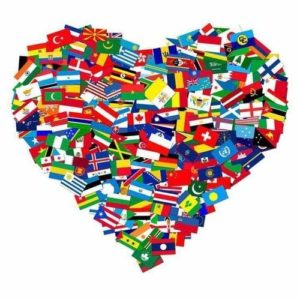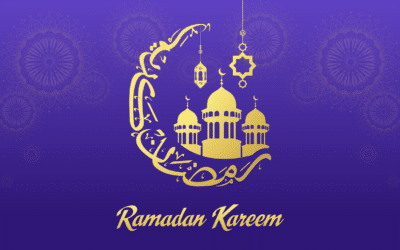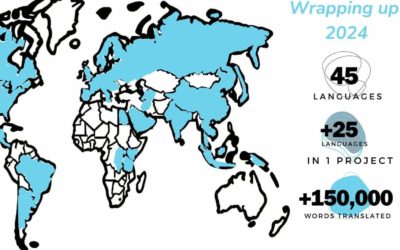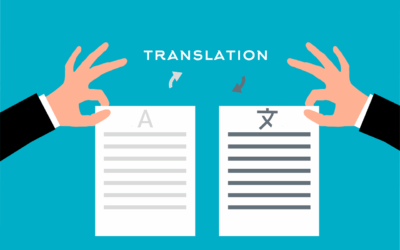Read our Translation Blog
Get the latest fun and facts from the language industry with our blog!
Need advice on website translation and localization?
Browse our ONLINE SHOP for ebooks on how to translate a website!
LingoStar’s Blog 
Welcome to LingoStar’s blog! On this page, you can find a lot of interesting and useful information about the translation industry. Explore topics on website translation and localization and how successful localization can influence your business to help your company grow and go global.
Language Blog Topics
On this blog, you can also learn about professional translators and interpreters, multilingual search engine optimization (SEO), the importance of socializing and networking and translators’ professional ethics. Quite often we write posts about the languages of the world, other cultures, and their traditions. Not only do translators convert texts from a source language to a target language, but they also help people communicate with each other, help establish international contacts, and are often prominent figures in the social, economic, and political life. Lastly, of course, we want you to have fun, so on our blog, you can find many posts that will entertain you and, hopefully, make you smile!
We hope you enjoy our blog and discover a lot of interesting things!
What Does Accessibility Mean in the Field of Translation?
Discover what accessibility means in the field of translation You may have heard the word “accessibility” before, but without fully understanding what it means, particularly in the context of translation. If you are curious and want to gain a better understanding of this concept, read on! What accessibility means: a brief definition To fully understand what we mean by “accessibility” it is important to distinguish between the word and the concept. According to the Cambridge Dictionary online, accessibility simply means “the quality of being easy to understand or enjoy”. However, as a concept, accessibility is defined as “the quality of being able to be entered or used by everyone, including people who have a disability”. The key word here is “disability”. Making a place, product or piece of information accessible means that everyone can access it, regardless of any disabilities they may have. Concrete examples If, after reading this first definition, you still don’t fully understand the concept of accessibility, don’t worry! Here are some examples of existing accessibility services: Audio description for the blind and visually impaired. A voice describes everything happening on the screen, enabling people to enjoy the action. This service also exists in certain museums to describe works of art. Subtitles for the Deaf and hard of hearing and/or closed captions. All sounds and dialogues are transcribed into subtitles. This service is also available in theatres and for some live events on television, where it is called live subtitling, ensuring real-time accessibility. Sign Language to help deaf people communicate in their everyday lives. It is also used for events on television, such as the news or short political addresses. Easy Languages for... read moreMultilingualism in Russia
Ethnic diversity and multilingualism in Russia Multilingualism in Russia has been a cornerstone of Russia’s cultural and political development throughout history. Much like the matryoshka doll, a worldwide symbol of Russian identity, the country comprises many interlocking languages and ethnic groups. This linguistic diversity offers a wealth of cultures and languages. However, it also presents challenges. Want to learn more? Keep reading! The historic roots of multilingualism in Russia From the Tsardom of Russia to the Russian Federation via Imperial Russia and the Soviet Union, multilingualism has always played a part in Russia’s history. Its vast territory brought together diverse peoples ranging from Eastern Europe to Northern Asia, resulting in a complex linguistic landscape that persists to this day. This legacy extended beyond Russia’s borders, especially into regions such as Moldova, shaped by centuries of Russian and Soviet influence. Following the annexation of Bessarabia (modern-day Moldova) by the Russian Empire and its subsequent integration into the Soviet Union, Russian became a dominant language in administration, education, and public life. Consequently, Moldova developed into a multilingual society. Nowadays, only Moldovan/Romanian is the official language; therefore, the majority of people speak it. However, Russian, Gagauz, Ukrainian and Bulgarian are also still spoken alongside Moldovan/Romanian. Russian remains influential, particularly in regions such as Gagauzia and Transnistria, reflecting the enduring impact of Russia’s multilingual and imperial past. Multilingualism in today’s Russia As the largest country in the world, Russia is home to multiple ethnic groups with their own languages and cultures. Around 190 ethnic groups speak between 100 and 150 different languages. Below is a non-exhaustive list of some of them: Armenian, Bashkir, Chuvash,... read moreWhat Is Localization: Bridging The Cultural Gap
What exactly is localization? “What exactly is localization and why is it so important today?” is a question worth asking in a globalized world where the internet and social media are bringing us all closer together. It is not only important that your product is available in several languages. It should also be correctly adapted to the target culture. The following article aims to provide information on the concept of localization and the benefits of localizing a product. The industry is relatively young. According to seasoned localization experts O’Hagan and Mangiron, the term was first used by software developers during the late 1980s. This was a time when companies found out that taking their product overseas was advantageous overall. The term “localization” refers to the process of adding and adapting cultural and linguistic elements that are foreign to the original product so that it is received positively in a foreign market. The term is commonly abbreviated to “l10n”. What is the difference between localization and translation? At first glance, you might think that localization is just another way of saying translation. However, this misconception is on the same level as thinking that translation is a simple language conversion, rather than a complex process that often involves technical terminology and attention to detail. In this sense, while translation involves the conversion of a text and its terms from one language to another, localization focuses more on the target culture of the product and its linguistic particularities. Ultimately, the main aim is to reach a wider market overall. For example, if you want your product to resonate with someone in the... read moreRamadan: The Holy Month of Islam
Discover Ramadan, the holy month of Islam Ramadan, the holy month of Islam and the ninth month of the Islamic lunar calendar, is celebrated worldwide. This year’s Ramadan began on Friday, February 28, 2025 and lasts until Saturday, March 29, 2025. But what do you know about this holiday? If you want to know more, read on! What is Ramadan, the holy month of Islam? Ramadan is considered the holy month of Islam because it is believed that the Quran was revealed during this time. Indeed, God revealed the holy book of Islam in Arabic to the Prophet Muhammad as a guide. To celebrate and commemorate this meaningful event, Muslims all over the world fast from dawn to sunset for a month. However, for Muslims, the holy month of Ramadan is not just about fasting: it’s about a spiritual reset! The rules of Ramadan, the holy month of Islam Muslims around the world celebrate the holy month of Ramadan according to the following rules: Fasting and not drinking from dawn to sunset, which is one of the five pillars of Islam. Praying the five usual mandatory prayers as well as nightly prayers known as Taraweeh. Strengthening one’s connection to God, especially by reading the Quran. Being charitable and generous to others. In fact, giving – known as Zakat – is mandatory and another of the five pillars of Islam. Showing forgiveness and mercy to everyone. Being patient, self-disciplined and humble. Spending time with fellow Muslims by praying and eating together. Celebrating Eid al-Fitr, which marks the end of the holy month of Ramadan. A global holiday More than 1.8... read moreEnglish to French Translation in Canada: An Introductory Guide
The importance of English to French translation in Canada English to French translation in Canada isn’t just a skill—it’s a crucial bridge connecting communities, businesses, and individuals across linguistic boundaries. With approximately 7.5 million French speakers primarily concentrated in Quebec, New Brunswick, Ontario, and Manitoba, translation is more than an extra option—it’s a cultural necessity. For businesses, providing materials in both English and French is a clear demonstration of respect for linguistic diversity. It enhances brand reputation, strengthens customer relationships, and ensures that French-speaking clients feel valued. Beyond the corporate world, translation plays a critical role in education, healthcare, and community services. Schools in bilingual regions must accommodate both languages to provide equal opportunities for students. At the same time, healthcare providers and social organizations rely on accurate translation to offer essential services without language barriers. English-to-French translation is not just a professional courtesy—it is a crucial aspect of fostering connection and ensuring equitable access to information and services within the Canadian community. The legal landscape of bilingual communication Canada’s bilingualism policy, established in the Official Languages Act (1969) and reinforced by the Constitution, mandates that federal institutions provide services in both English and French. This ensures: Government services are accessible in both languages. Public announcements are communicated bilingually. Educational institutions accommodate both linguistic groups. At the provincial level, policies vary. Quebec’s Charter of the French Language prioritizes French in public life, business, and education, requiring people to adapt to regional legal and cultural contexts. Beyond compliance, Canada’s bilingualism policy promotes language learning and cultural exchange. Translators play a key role in supporting these efforts by ensuring clear, accessible... read moreAdd Captions to Reels: A Different Way of Enjoying Social Media Content
The perception of video captioning on social media If you’re scrolling through your phone and watching reels without sound, you can still follow along because most creators include captions. Audio is rarely essential for audiovisual content. Nowadays, every video on Instagram, TikTok, or even on YouTube reels has captions incorporated. Captions can be translated using the same automatic transcription and translation that we see on YouTube videos. But translations or transcriptions are not always accurate! This can happen if the video lacks clear audio. Even when the audio quality is good, the transcription may struggle to match the sentence structure, so humour may be lost in the literal translation. However, users can make small manual adjustments if needed. Cross-cultural communication at hand Captions can help bridge language barriers, allowing non-native speakers to understand sociological discussions and research findings. A great expert on media communication, Richard Grusin affirmed that media technologies construct and mediate experiences, leading to a new reconfiguration of how we understand certain concepts. Read The Future of Translation: Bridging Tradition and Innovation to learn how technology is leading to changes in the translation industry. Many applications offer the possibility of adding captions to videos (CAPCUT or iMovie for iOS) instantly, even in real time while the speaker is speaking. The creator will spend more time thinking about what to say rather than editing the video because these applications simplify many of the processes. This is a more efficient way of working because you only need to fine-tune the video script that has already been translated. Adding captions to reels as a means of accessibility and awareness Why add... read moreTranslation Projects 2024: A Festive Linguistic Journey
As the holiday bells chime and snowflakes dance, we at LingoStar Language Services are excited to unwrap our linguistic adventures from our translation projects 2024! Celebrating a Year of Global Communication in Translation Projects 2024 As we approach the most wonderful time of the year, we’re not just exchanging gifts. We’re sharing moments of joy, connection, and linguistic magic. If we could sum up our language projects in one word, it would be “share” – celebrating by connecting cultures, bridging languages, and spreading joy across continents. Every year brings its own tapestry of experiences, and 2024 is no exception. It’s a time to pause, reflect, and appreciate the milestones we’ve reached and the lessons we’ve learned along the way. What Translation Projects 2024 Lit Up Our Year? In our translation projects 2024, LingoStar transformed language barriers into global opportunities: Translated documents across 45 languages Translated English to French (Canadian), Spanish (Latin American) and Chinese as the most requested language pairs Simultaneous work on 25 languages in single projects Translated over 150,000 words Specialized translation projects including: French Canadian e-learning voiceover recordings Ethical hotline message translations in major European, Asian, and Indian languages Complex medical record transcriptions and translations in Hindi and Punjabi Wrapping Up Our Translation Projects 2024 Journey This year has been a wonderful journey of collaboration, learning, and connecting with amazing linguists and clients worldwide. We’ve worked with trusted translators, welcomed new linguistic talent, and continued to expand our global communications horizons. 🎁 LingoStar Video: Your Global Communication Superpower Need some translation magic? Since 2005, we’ve been transforming language barriers into business opportunities for Canadian companies. Our... read moreTranslation Companies: Life Partners for Your Multilingual Needs
Translation companies: Partners for your multilingual business Language company services are a cornerstone of successful global interactions, providing the necessary support to overcome language barriers. In today’s multicultural environment, communicating clearly and effectively with diverse audiences is essential for business growth. Quality translation services ensure companies can share their vision and values, facilitating stronger connections in international markets. With the right translation company, businesses can effortlessly navigate the complexities of multilingual communication. Which translation companies are right for your business? Choosing the right translation company is crucial for any business looking to expand globally. When evaluating translation companies, consider their expertise, range of services, and client reviews. A reputable translation company should offer not only basic document translation but also specialized options such as certified translation, marketing translation, software translation, technical and legal translation, and voice-over services to ensure that the nuances of your specific content are preserved. At LingoStar, we specialize in the IT and business sectors and deliver tailored solutions that meet your needs. Additionally, you can check our client reviews and testimonials to see the reliability and quality of our services. Our professional translators ensure that your message resonates with your target audience, taking into account both linguistic accuracy and cultural adaptation. Translation companies’ quality assurance Quality assurance is essential for any reputable translation company. At LingoStar, we implement rigorous processes and professional standards to ensure the accuracy and consistency of our translations. Our quality assurance includes multiple rounds of editing and proofreading, ensuring that your content is not only translated, but also polished to perfection. This commitment to quality helps us build long-term partnerships with our clients, ensuring they receive exceptional service every time. Long-term partnership... read moreHow to Start a Translation Business: Your Step-by-Step Guide to Success and Profitability
Building Your Foundation to Start a Translation Business Are you passionate about languages and eager to turn your skills into a thriving enterprise? Learning how to start a translation business can be an exciting and rewarding venture. This guide will walk you through the essential steps to starting and growing a profitable translation business, even if you’re new to the world of entrepreneurship or translation. How to Start a Translation Business: Your Step-by-Step Guide to Success and Profitability Educational background for your translation business While formal education isn’t always mandatory, a strong educational background can give you a significant advantage when starting a translation business. Consider the following: Bachelor’s degree in linguistics, foreign languages, or translation studies Master’s degree in translation or interpreting Certification from professional translation organizations Remember, continuous learning is key in this ever-evolving field. Stay abreast of language trends and industry developments to maintain your competitive edge as you start and grow your translation business. Developing business acumen To run a successful translation business, you’ll need more than just language skills. Here’s how you can build your business skills: Take online courses in business management and entrepreneurship Attend marketing and finance workshops for small businesses Join local business networking groups to learn from experienced entrepreneurs Invest time in an internship with a translation company. Therefore, these skills will be crucial as you start a translation business and work towards profitability. Launching your translation business If you want to stand out in a crowded market when starting a translation business, consider specializing in a specific area: Identifying your niche To stand out in the crowded market when... read moreDay of the Dead: A Day to Remember!
Day of the Dead and Mexico’s festivities Mexico has many annual celebrations, but one of the most iconic is the Day of the Dead. Along with the Day of the Dead and its various festivals and carnivals, the country has several other great celebrations, each with its own unique quirks and fun things to do! Almost all of the country’s national holidays are designed as an opportunity to remember Mexico’s heritage and enjoy its culture. For example, the February carnivals in cities such as Veracruz, Ciudad de México and Mérida celebrate Mexico’s religious and indigenous heritage. Of course, some are more serious and celebrate important political events, such as Mexico’s Independence Day on 16 September. The Day of the Dead could be seen as something in between: remembering our deceased family members is serious, yes, but why not celebrate their lives instead of mourning their deaths? What is Day of the Dead all about? The Day of the Dead tradition blends Mesoamerican rituals with some elements of European religions and dates back 3,000 years. The Aztec and Nahua people believed that death was as important as life because they saw the universe as a cycle of birth and death of all things. So instead of seeing death as the end, they saw it as another step on the journey. In the myth of the Day of the Dead, a person travels to Chicunamictlán, or the Land of the Dead, where they die. The soul’s goal is to reach its final resting place, known as Mictlán. The festival takes place every year between 31 October and 2 November. According to... read moreLanguages Spoken in the USA: A Melting Pot of Cultures
The USA: A place for everyone | Discover the languages spoken in the USA The USA has always been known for its diversity. Many languages are spoken in the USA. More than three billion people call the United States of America home. Due to its diverse population before British colonization and several waves of immigration, you can find almost every language and cultural background in the US population. The USA has been multilingual since the very beginning. Many languages were spoken in the USA, even before the first settlers set foot on its soil. Tribes, such as the Navajos, Sioux and Keresan spoke over a thousand known languages before first contact with Europeans. Evolution of the English language in the USA When considering why and how a language develops, there are several factors to consider. One of the most important is culture. It is said that the influence of foreign languages spoken in the USA is much more immediate and recent than in any other country. The English language has developed a lot in the USA. For example, some terms have been taken from the languages of the native tribes, such as the word “raccoon”, which was taken from the Powhatan term aroughcun, meaning “animal that scratches with its hands”. You can easily find examples of words being coined from many other languages! Other well-known examples are avocado and canyon from Spanish, and chowder and prairie from French. How many languages are spoken in the USA? With so many cultures co-existing, you may be wondering: How many languages do I need to learn to get around the country? Just... read moreSummer in Italy: An Unforgettable Experience
Unveiling the enchantment of Italy Summer in Italy is a vibrant season of cultural festivals, lively events and warm weather, making it the ideal time to explore and enjoy the country. Italy captivates visitors with its diverse and vibrant offerings. Located in southern Europe, Italy is a boot-shaped peninsula that juts into the Mediterranean Sea. It is renowned for its summer festivals, each reflecting the country’s rich cultural heritage and regional traditions. Immerse yourself in Italian culture: Experience a summer in Italy Italy is known for its rich and varied culture, and getting together is an important part of the country’s traditions. Ferragosto, the day of the Assumption of Mary, is a national cultural festival held on 15th August. This day, everyone celebrates with family reunions, beach trips and fireworks. Many towns and cities hold local festivals and processions. With its diverse landscapes, historic sites, and cultural attractions, Italy offers endless opportunities for summer exploration. Explore ancient ruins such as the Colosseum and the Roman Forum in Rome or visit the Vatican City, marvel at Renaissance art in Florence, or enjoy the modern elegance of Milan. Take in the stunning scenery and views of charming towns like Positano and Amalfi or take a boat tour through Venice. Summers in Italy are enchanting. Also, the summer festivals and other cultural events fuel the country’s music, sports and tourism industries. Summer in Italy: Festivals and cuisine Summer in Italy is synonymous with vibrant festivals. In July and August, the historic Palio di Siena, a thrilling horse race, transforms Siena’s Piazza del Campo into a medieval extravaganza. Venice celebrates the Festa del... read moreThe History of Arabic and Its Relationship with Yemen
The enduring legacy of Arabic Immerse yourself into the rich history of Arabic and its enduring legacy around the globe. It is a journey through the ages of cultural and intellectual growth emanating from the Arabian Peninsula. With its deep history and global influence, it has provided a wealth of culture and communication for centuries. At LingoStar, we recognize the impact of Arabic and strive to bring its beauty and precision to your doorstep through our expert translation services. Origin and evolution The historical Arabic language has many claims to fame spanning from being the original language of poetry to the sacramental language of Islam. First appearing in the 4th century CE it grew and expanded rapidly. Its adoption as the official language of Islam in the 7th Century not only cemented Arabic’s importance but also facilitated its spread throughout the Middle East, North Africa, and parts of Europe, making it a key language for culture, science, and philosophy. Today, more than 400 million people speak Arabic in over 20 countries. Classic and modern Arabic: What’s the history of Arabic? The key aspect of the history of Arabic is its evolution from Classical to Modern Standard Arabic (MSA). While its ancient roots are preserved in academic, literary, and religious texts such as the Quran, the Arabic language has also been thrust into modernity as a necessity for contemporary communication, serving the vast Arabic-speaking world. Today, these two forms serve different purposes and convey many different ideas. Therefore, understanding these differences is crucial for effective translation services, ensuring both historical accuracy and modern relevance. Yemen’s contribution to the history of Arabic... read moreLanguages in India: A Landscape of Linguistic Diversity
Multilingualism of India Let’s talk about India and the languages in India. India is a country largely known for its cultural and linguistic diversity. It boasts over 700 languages. At the same time, it is home to the world’s most linguistically diverse population, showcasing India’s unique tapestry reflecting its rich heritage and history. Therefore, for a business aiming to tap into this diverse market, effective communication is key. As a leading language translation company, LingoStar translators recognize the crucial importance of embracing linguistic diversity in building meaningful connections and fostering growth. The major languages in India Hindi is the official language of India, as declared by the Indian government. It is spoken by nearly 44% of the population and it acts as a lingua franca in many parts of the country. Alongside Hindi, English is one of the languages in India that holds a significant place as an associate official language. Other major languages in India include Bengali, Telugu, Marathi, Tamil, and Urdu, each with millions of speakers and a deep literary tradition. Why do languages matter in India? Effective communication between the languages of India goes beyond mere translation; it also involves the localization of its cultures. Each state often has its own official language, such as Bengali in West Bengal, Tamil in Tamil Nadu, Telugu in Andhra Pradesh, and Marathi in Maharashtra. Therefore, if you do business in India, this means tailoring your message to align with local sensibilities and cultural nuances. As a result, consumers are more likely to engage with content that acknowledges and respects their linguistic and cultural identities. The importance of translating languages... read moreEnvironmental Translation: How Translation Can Contribute to Sustainable Development
Can translators help to improve our environment? The world is facing an environmental crisis. Climate change, biodiversity loss, pollution, deforestation, ecosystem degradation, and natural resource depletion are some of the consequences of human activity. Tackling the global environmental crisis requires individual and collective efforts across different sectors and levels of society to protect future generations. Environmental translation is essential to introduce new regulations and to create campaigns in a globalized world. What is environmental translation? Environmental translation refers to the translation of environmental or scientific documents from one language into another. Some of these documents include policies, regulations, laws, assessments, sustainability reports, agreements, plans, articles and educational materials. There are several purposes for environmental translation or interpretation. This type of language conversion can be used to communicate effectively with diverse audiences and to address environmental issues on a global scale. What to look for in an environmental translator? Professional environmental translators are linguists who specialize in translating documents related to the environment. Environmental translation involves complex concepts, technical terminology, and specific jargon that may not be easily understood by those without expertise in the field. Translators must be familiar with specific areas of environmental science, such as climate change, sustainability, ecology, renewable energy, conservation, waste management, etc. Environmental translators and interpreters must be fluent in both the source and target languages. But, also have an extensive knowledge of environmental vocabulary and concepts. They must be familiar with specialized dictionaries, glossaries and terminology databases to ensure consistency in translations. They must also keep abreast of new developments, trends and terminology in the field. In addition, it is normal for some... read moreTranslation Blog and News
LingoStar has been a language services provider in Canada, the USA, and Europe for more than a decade. We are proud to say that we cooperate with professional translators, interpreters, and other language specialists worldwide and work with over 100 language pairs. If you are looking for a reliable translation company, contact LingoStar! We are always ready to help you with your projects and documentation. Get a free quote online.















